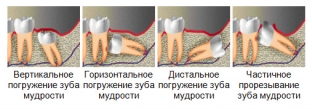Those who have already experienced the stage of wisdom teeth eruption know that this process brings a lot of inconvenience and discomfort. Many people ignore going to the doctor and experience real torment, which is delivered by faithful companions of the process of teething wisdom teeth. This process is characterized by an increase in body temperature, the occurrence of headaches, pain in the ear, jaw and throat. Failure to timely remove wisdom teeth is fraught with the loss of perfectly healthy adjacent teeth and the development of more serious complications. What to expect during the wisdom teething process and when to perform an immediate extraction of teeth, find out in the article.
Problems related to wisdom teeth
Problem #1 Increased risk of caries
Because there is not enough room for wisdom teeth in the jaw, they can be placed in the wrong position. If an inclination is formed towards the adjacent tooth, food accumulates in the gap between them. Often in this place, brushing the teeth is difficult, and therefore caries forms on the adjacent tooth. Also, during the growth of the wisdom tooth, it is quite difficult to clean it, which provokes the accumulation of bacteria in this place, for this reason, caries develops.
Problem #2. Impacted wisdom tooth
Such a wisdom tooth has not erupted and is located inside the jawbone or under the gum. It will burn to behave differently: it can either not cause any inconvenience at all, or it can be a rather serious problem. Such a tooth can put pressure on the roots of an adjacent tooth, causing their resorption. As a result, there are headaches and pain in the jaw, ear or throat. If the pain does not go away, you should immediately visit the dentist, because ignoring the timely removal of wisdom teeth, you can lose healthy teeth and adjacent teeth.
Problem #3. dystopic wisdom tooth
The phenomenon when the tooth is in the wrong position – a consequence of the lack of space for him. It happens that wisdom teeth erupt towards the cheek, injuring its mucous membrane. In addition, a dystopic tooth often affects the position of adjacent teeth, resulting in a change in bite. Since such circumstances cause considerable discomfort, the removal of wisdom teeth of this type is certainly required.

Problem #4. Difficulty eruption
Since there was no milk tooth in the place where the wisdom tooth was cut before, the gum is not prepared for eruption. Also, difficulties arise due to the fact that the tooth begins to grow already in adulthood, therefore, by the time it erupts, the jaw bones are fully formed. These circumstances force the wisdom tooth to make its way with difficulty, which results in inflammation of the tissues that surround the tooth. As a result, body temperature rises and pain occurs, which can make it difficult to even open your mouth. Sometimes teething also causes pain in the ear and throat.
As for the time it takes for a wisdom tooth to grow, it is usually a rather long process. In order not to suffer regularly from unbearable pain, it is better to immediately contact a specialist who can help get rid of discomfort.
Problem #5. Periodontitis
In circumstances where it is not possible to properly clean the yellow plaque from the wisdom tooth and carry out the removal of tartar, periodontitis may occur. So, around the tooth starts the process of accumulation of bacteria that cause inflammation of the gums. Ignoring such a problem leads to infection in the bone, which is fraught with osteoperiostitis. In this regard, the removal of the wisdom tooth is also necessary.
Problem #6. Pericoronitis
As the tooth erupts, a so-called hood is formed between it and the gum, which acts as a place for the accumulation of pericoronitis, purulent inflammation. The latter are manifested by such symptoms as swelling of the gums, unbearable pain, bad breath, when pressed, an unpleasant aftertaste occurs, and the temperature rises. If such a hood was not removed in a timely manner, the inflammatory process can spread to the periosteum of the jaw and even the bone.
How to relieve pain when a wisdom tooth is cut?
When the tooth is positioned correctly, it is enough to remove the hood over the wisdom tooth, which facilitates eruption. In addition, folk remedies for pain relief are popular. So, in order to relieve inflammation, antiseptic solutions are used to rinse the mouth. In this way, it is possible to disinfect injured gums, but often such measures are not enough to completely neutralize the problem. In this regard, as soon as pain occurs, you should seek help from a specialist as soon as possible, because the removal of wisdom teeth – the most optimal solution.








Add a comment